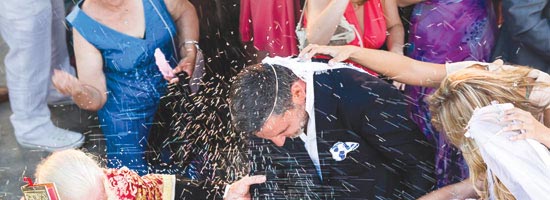Nuptial bliss is in the air! June, symbolic of the Roman Goddess of love and marriage, (Juno) spews marital vows, the exchange of wedding bands and the beginning of a new chapter in the lives of couples.
The Caribbean exuberates diversity, which is illustrated through the endless beautiful gowns, vibrant music, and deep rooted, cultural traditions. Celebrating these wonderful unique pointers, Candice Stewart shares fascinating wedding traditions practiced found around the world helping to add some extra flare and style to your special day. The following ceremonies listed below, are some of BUZZZ Magazine’s favourite wedding traditions, in hope of inspiring newlyweds coming together, joining hands in matrimony expressing their love mind, body and soul!
Africa
As Africa is a continent with many countries, we will share general practices. Brides and grooms sometimes choose handwoven fabrics called Kente, which makes the couple royalty on their wedding day. A Ghanaian tradition, brides wear either a dress or blouse and a long skirt accompanied with a shawl and a headpiece all made from the same material and colour of choice. The groom wears either a dashiki or a tunic with matching pants accompanied with a head piece in the shape of a hat. The colour and design chosen by the bride for her outfit is used by the groom so that they match. The colours chosen are usually purple (symbolic of royalty), and earth tones.
Love Rituals
The Beauty Treatment
The day of the wedding greets the bride with beauty treatments like a coconut oil massage and special perfume and henna applications. The groom undergoes rituals known as Kupeka Begi where his female relatives take gifts to his bride on his behalf. The bride’s female relatives then perform a ritual known as Kupeka Msuaki where they bring a gift of toiletries to the groom on her behalf. This culminates in the traditional chakacha dance right before the actual wedding ceremony begins.
Tying the Knot
The couple’s wrists are tied together with cloth or braided grass to represent their marriage. The act symbolises their unity. It is executed by the officiant or a close friend who tie the bride and groom’s wrists together with a piece of Kente cloth or a strand of braided grass with cowrie shells (symbols of fertility and prosperity), to affirm their commitment.

Jumping The Broom
In culminating the wedding ceremony, the couple places a colourful and usually handmade broom on the floor, they face the audience and they jump over the broom. The broom is usually kept in the couple’s home after the wedding as a symbol of the leap they made to love and cherish each other forever. This broom ceremony represents the joining of two families, showing respect and pays homage to ancestors and the beauty of the African heritage.
To continue reading , purchase Vol. 7 #10 2015 issue


Share this post:
Nuptial bliss is in the air! June, symbolic of the Roman Goddess of love and marriage, (Juno) spews marital vows, the exchange of wedding bands and the beginning of a new chapter in the lives of couples.
The Caribbean exuberates diversity, which is illustrated through the endless beautiful gowns, vibrant music, and deep rooted, cultural traditions. Celebrating these wonderful unique pointers, Candice Stewart shares fascinating wedding traditions practiced found around the world helping to add some extra flare and style to your special day. The following ceremonies listed below, are some of BUZZZ Magazine’s favourite wedding traditions, in hope of inspiring newlyweds coming together, joining hands in matrimony expressing their love mind, body and soul!
Africa
As Africa is a continent with many countries, we will share general practices. Brides and grooms sometimes choose handwoven fabrics called Kente, which makes the couple royalty on their wedding day. A Ghanaian tradition, brides wear either a dress or blouse and a long skirt accompanied with a shawl and a headpiece all made from the same material and colour of choice. The groom wears either a dashiki or a tunic with matching pants accompanied with a head piece in the shape of a hat. The colour and design chosen by the bride for her outfit is used by the groom so that they match. The colours chosen are usually purple (symbolic of royalty), and earth tones.
Love Rituals
The Beauty Treatment
The day of the wedding greets the bride with beauty treatments like a coconut oil massage and special perfume and henna applications. The groom undergoes rituals known as Kupeka Begi where his female relatives take gifts to his bride on his behalf. The bride’s female relatives then perform a ritual known as Kupeka Msuaki where they bring a gift of toiletries to the groom on her behalf. This culminates in the traditional chakacha dance right before the actual wedding ceremony begins.
Tying the Knot
The couple’s wrists are tied together with cloth or braided grass to represent their marriage. The act symbolises their unity. It is executed by the officiant or a close friend who tie the bride and groom’s wrists together with a piece of Kente cloth or a strand of braided grass with cowrie shells (symbols of fertility and prosperity), to affirm their commitment.
Jumping The Broom
In culminating the wedding ceremony, the couple places a colourful and usually handmade broom on the floor, they face the audience and they jump over the broom. The broom is usually kept in the couple’s home after the wedding as a symbol of the leap they made to love and cherish each other forever. This broom ceremony represents the joining of two families, showing respect and pays homage to ancestors and the beauty of the African heritage.
To continue reading , purchase Vol. 7 #10 2015 issue
Share this post: